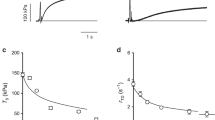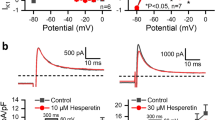Abstract
HISTOLOGICAL fixatives act by combining with and forming links between reactive groups of biological molecules, but even in the usual strong concentrations they do not destroy all chemical and physical properties of the original living material. The activity of some enzymes, for example, remains after fixation1. Recently the effect on excitable membranes of weak solutions of fixatives has been examined with electrophysiological techniques which allow the results of physico-chemical changes to be followed as they develop. In cardiac Purkinje fibres the plateau phase of the action potential is prolonged by formaldehyde2. In skeletal muscle the usually brief action potential acquires a long-lasting plateau during exposure to formaldehyde3. Because the conductance of the skeletal muscle membrane is high during the induced plateau, formaldehyde can be supposed to act either by slowing the inactivation of the sodium conductance or by causing a loss of specificity of the more slowly operating potassium conductance system in favour of sodium3. A prolongation of the action potential of probably similar nature has also been reported in crayfish nerve fibres exposed to various aldehydes4.
This is a preview of subscription content, access via your institution
Access options
Subscribe to this journal
Receive 51 print issues and online access
$199.00 per year
only $3.90 per issue
Buy this article
- Purchase on Springer Link
- Instant access to full article PDF
Prices may be subject to local taxes which are calculated during checkout
Similar content being viewed by others
References
Everson Pearse, A. G., Histochemistry, 1 (Churchill, London, 1968).
Fozzard, H., and Dominguez, G., J. Gen. Physiol., 53, 530 (1969).
Dominguez, G., and Hutter, O. F., J. Physiol., 204, 98P (1969).
Shrager, P., Macey, R., and Strickholm, A., Biophys. J., 9, A-60 (1969).
Katz, B., Arch. Sci. Physiol., 3, 285 (1949).
Falk, G., and Fatt, P., Proc. Roy. Soc., B, 160, 69 (1964).
Eisenberg, R. S., and Gage, P. W., J. Gen. Physiol., 53, 279 (1969).
Eisenberg, B., and Eisenberg, R. S., Science, 160, 1243 (1968).
Adrian, R. H., J. Physiol., 175, 135 (1964).
Adrian, R. H., Chandler, W. K., and Hodgkin, A. L., J. Gen. Physiol., 51, 188s (1968).
Howell, J. N., J. Physiol., 201, 515 (1969).
Author information
Authors and Affiliations
Rights and permissions
About this article
Cite this article
HUTTER, O. Potassium Conductance of Skeletal Muscle treated with Formaldehyde. Nature 224, 1215–1217 (1969). https://doi.org/10.1038/2241215a0
Received:
Issue Date:
DOI: https://doi.org/10.1038/2241215a0
This article is cited by
-
Accumulation of formaldehyde causes motor deficits in an in vivo model of hindlimb unloading
Communications Biology (2021)
-
Pharmacology of calcium release from sarcoplasmic reticulum
Journal of Bioenergetics and Biomembranes (1989)
Comments
By submitting a comment you agree to abide by our Terms and Community Guidelines. If you find something abusive or that does not comply with our terms or guidelines please flag it as inappropriate.



